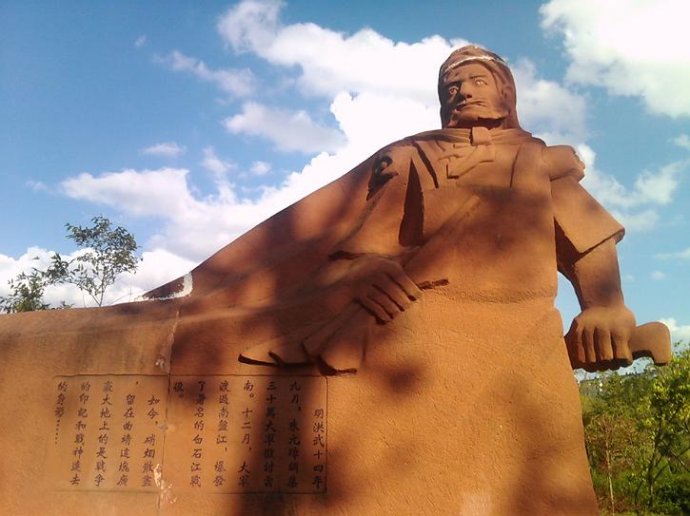
Baishijiang Ancient Battlefield in Qilin District, Qujing
The First Major Battle to Unify Yunnan during the Ming Dynasty – The Baishijiang Battle曲靖麒麟区白石江古战场
Historical Overview of the Baishijiang Battle
In the first month of 1368, Zhu Yuanzhang (朱元璋), the founding emperor of the Ming Dynasty, established the Ming Dynasty in Nanjing (应天府, now Nanjing). At the beginning of the Ming, the dynasty was unable to wage military campaigns in the remote southwestern region of Yunnan (云南), which was mountainous and difficult to access. Zhu Yuanzhang sought a peaceful unification of Yunnan.
Zhu Yuanzhang sent envoys to Yunnan to persuade local leaders to surrender, making five attempts in total. Among these attempts, three were notably detailed:
- In the fifth year of Hongwu (洪武五年, 1372), he dispatched Wang Hui (王袆), an official from the Hanlin Academy, to Kunming (昆明) to communicate with the “Liang Wang” (梁王) Bazhaci (巴匝刺瓦尔密), a descendant of the Yuan dynasty’s Shizu. Wang Hui urged Bazhaci to surrender Yunnan to avoid warfare, allowing him to retain his old titles and privileges. Wang Hui warned that if they resisted, the Ming army would inevitably arrive, leading to regrettable consequences. Bazhaci was initially persuaded but was soon pressured by a representative from the Northern Yuan (北元), resulting in the execution of Wang Hui.
- In the seventh year of Hongwu (洪武七年, 1374), Zhu Yuanzhang sent a son of the Yuan dynasty’s Weishun Wang, who had already surrendered to the Ming, to persuade Bazhaci to surrender.
- In the eighth year of Hongwu (洪武八年, 1375), he sent Wu Yun (吴云) to Kunming, but Wu was ambushed and killed by a former subordinate of Bazhaci, complicating the negotiations further.
After multiple failed attempts to persuade the Liang Wang to surrender, Zhu Yuanzhang’s hope for a peaceful resolution was dashed.
In 1381, after over ten years of consolidation, the Ming Dynasty’s power became stable, with a strong economy and sufficient resources for a military campaign. In September, Zhu Yuanzhang appointed General Fu Youde (傅友德) to lead an army of 300,000 troops to subdue Yunnan and achieve national unification.
The massive army included units from various provinces, and on the day of departure, Zhu Yuanzhang reviewed the troops at Liushuwan in Nanjing. The army sailed down the Yangtze River toward Wuchang, where Zhu Yuanzhang briefed Fu Youde on strategies for the campaign, emphasizing the importance of taking Qujing (曲靖), which was deemed a strategic chokepoint.
By December, the Ming army had taken key areas in modern Guizhou, advancing swiftly toward Qujing.
The Climactic Battle at Baishijiang
Knowing that the Ming army was approaching, Bazhaci deployed over 100,000 elite troops along the southern bank of Baishijiang, led by the Yuan provincial prime minister, Dali Ma (达里麻). The battle was imminent, with both sides preparing for confrontation. Bazhaci underestimated the speed and determination of the Ming forces.
As the Ming army approached, a thick fog enveloped the area, allowing them to advance unnoticed. Once the fog lifted, the Ming troops spotted Bazhaci’s forces on the southern bank. General Mu Ying (沐英) advised General Fu Youde to act quickly and to surprise the enemy.
Fu Youde positioned his troops as if preparing to cross the river. The Yuan commander, Dali Ma, panicked upon seeing the Ming forces and concentrated his troops defensively. Meanwhile, Fu Youde dispatched several thousand soldiers downstream to cross the river stealthily, creating chaos among Bazhaci’s ranks.
With the Yuan troops distracted, the Ming army successfully crossed the river and launched a fierce attack, leading to heavy casualties among Bazhaci’s forces. The battle was brutal, resulting in a decisive victory for the Ming Dynasty, with Dali Ma and over 20,000 Yuan soldiers captured.
Aftermath and Significance
The victory at Baishijiang opened the path for the Ming army to advance into Kunming, ultimately leading to the unification of Yunnan. Bazhaci was left with no means to resist and took his own life in Jinning (晋宁). The remnants of the Yuan forces surrendered, allowing the Ming to swiftly consolidate control over Yunnan.
In commemoration of this historical event, a statue has been erected in Baishijiang Park (白石江公园) to honor the memory of those who fought and died in the battle.
How to Get There
To reach Baishijiang Ancient Battlefield in Qilin District, Qujing, you can take a bus or drive from Kunming. The journey takes about two hours by car. Local transportation options are available in Qujing, making it easy to reach the site.
Travel Tips
- Best Time to Visit: The best time to explore the battlefield is during the spring and autumn months when the weather is pleasant.
- Local Guides: Consider hiring a local guide to learn more about the historical significance of the area.
- Cultural Respect: Be mindful of the historical context and respect the memorial site.
- Nearby Attractions: Explore other historical sites in Qujing, including the local temples and parks that highlight Yunnan’s rich cultural heritage.

 7 Days GolfingTour
7 Days GolfingTour
 8 Days Group Tour
8 Days Group Tour
 8 Days Yunnan Tour
8 Days Yunnan Tour
 7 Days Shangri La Hiking
7 Days Shangri La Hiking
 11 Days Yunnan Tour
11 Days Yunnan Tour
 6 Days Yuanyang Terraces
6 Days Yuanyang Terraces
 11 Days Yunnan Tour
11 Days Yunnan Tour
 8 Days South Yunnan
8 Days South Yunnan
 7 Days Tea Tour
7 Days Tea Tour
 8 Days Muslim Tour
8 Days Muslim Tour
 12 Days Self-Driving
12 Days Self-Driving
 4 Days Haba Climbing
4 Days Haba Climbing
 Tiger Leaping Gorge
Tiger Leaping Gorge
 Stone Forest
Stone Forest
 Yunnan-Tibet
Yunnan-Tibet
 Hani Rice Terraces
Hani Rice Terraces
 Kunming
Kunming
 Lijiang
Lijiang
 Shangri-la
Shangri-la
 Dali
Dali
 XishuangBanna
XishuangBanna
 Honghe
Honghe
 Kunming
Kunming
 Lijiang
Lijiang
 Shangri-la
Shangri-la
 Yuanyang Rice Terraces
Yuanyang Rice Terraces
 Nujiang
Nujiang
 XishuangBanna
XishuangBanna
 Spring City Golf
Spring City Golf
 Snow Mountain Golf
Snow Mountain Golf
 Stone Mountain Golf
Stone Mountain Golf



















